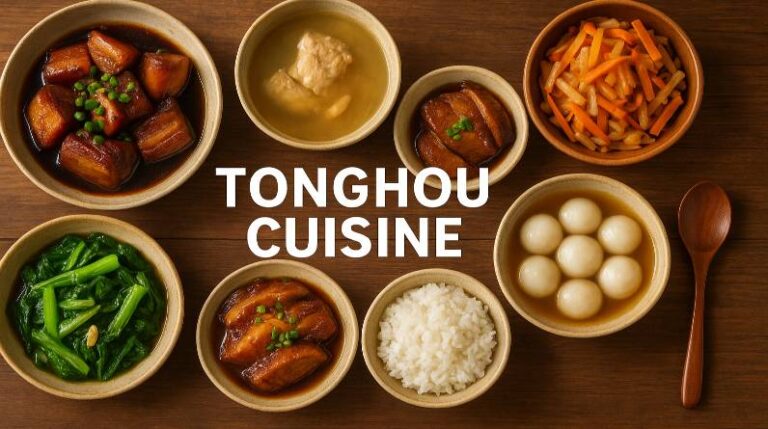Introduction: Discovering Tonghou
When most people think of Chinese cuisine, iconic dishes like Peking duck, dim sum, or Sichuan hot pot come to mind. Yet, beyond these global favorites lies Tonghou cuisine, a regional culinary treasure that blends history, culture, and innovative cooking techniques. Rooted in eastern China’s fertile landscapes, Tonghou dishes offer a remarkable balance of flavors—from savory and aromatic to subtly sweet. Unlike mainstream Chinese food trends, Tonghou maintains a rustic authenticity, showcasing ingredients and techniques passed down through generations.
Exploring Tonghou is not just a gastronomic adventure—it is a journey through the region’s history, traditions, and local ingenuity.
The Historical Roots of Tonghou Cuisine
Tonghou cuisine dates back several centuries, originating in a small town famed for its bustling markets filled with fresh produce and aromatic herbs. Its evolution is intertwined with:
- Agricultural traditions: The region’s fertile land encouraged diverse crop cultivation, providing an abundance of vegetables, grains, and proteins.
- Dynastic influences: Different Chinese dynasties contributed unique spices, cooking methods, and presentation styles, enriching Tonghou’s culinary complexity.
- Cultural exchanges: Trade routes, including the Silk Road, introduced exotic ingredients like spices and fermented products, which became integrated into local recipes.
Unlike many other regional cuisines whose fame rests on a few signature dishes, Tonghou has remained a living culinary culture—dynamic, adaptive, yet deeply rooted in tradition.
Signature Ingredients and Pantry Staples
Tonghou cuisine’s distinctiveness comes from its careful selection of ingredients and precise balance of flavors. Some staples include:
| Ingredient | Role in Cuisine | Example Use |
| Soy Sauce (Aged/Naturally Brewed) | Umami and depth | Braised Pork Belly |
| Sesame Oil | Aroma and richness | Stir-fried greens |
| Fermented Bean Paste | Complex, mellow umami | Braised Fish |
| Star Anise & Cassia Bark | Warmth and spice | Slow-braised meats |
| Root Vegetables (Daikon, Carrots, Potatoes) | Texture and substance | Braised Vegetable Dishes |
| Fresh Herbs (Cilantro, Scallions) | Brightness and garnish | Noodle soups, stir-fries |
This diverse ingredient base allows Tonghou chefs to create multi-layered dishes that balance richness, subtle sweetness, and aromatic notes without overwhelming the palate.
Cooking Techniques: Balancing Tradition and Flavor
Tonghou’s culinary philosophy emphasizes methods that enhance natural flavors and preserve nutritional value. Key techniques include:
- Slow braising: Ideal for tougher meats like pork belly, allowing flavors to penetrate while tenderizing the protein.
- Stir-frying: Maintains the crispness of vegetables while enhancing aroma through quick high-heat cooking.
- Steaming: A technique that preserves vitamins, minerals, and the fresh essence of ingredients.
- Pickling and fermentation: Not just for preservation but for creating complex umami layers in dishes.
The combination of these techniques ensures that every dish is both satisfying and nutritionally balanced—a hallmark of Tonghou cuisine.
Regional Variations and Flavor Profiles
Tonghou cuisine is far from monolithic. Regional differences reflect the local environment and ingredient availability:
- Coastal regions: Emphasize seafood dishes, such as braised fish with fermented bean paste, often served in light aromatic broths.
- Inland areas: Focus on hearty dishes featuring mushrooms, wild game, and root vegetables slow-cooked in savory sauces.
- Street food culture: Offers innovative twists, like spicy dumplings, savory pancakes, and noodle soups infused with local herbs.
These variations illustrate the adaptability of Tonghou cuisine, allowing it to thrive across different geographic and cultural contexts.
Must-Try Tonghou Dishes
For anyone seeking an authentic Tonghou experience, these dishes provide an essential introduction:
Main Courses
- Tonghou Braised Pork Belly: Pork slowly simmered with soy sauce, rice wine, and aromatic spices until tender.
- Five-Spice Fragrant Chicken: A dry-rubbed chicken steamed or roasted with star anise, cassia, and fennel for a fragrant, moist dish.
- Braised Fish with Fermented Bean Paste: A coastal favorite blending umami-rich bean paste with tender fish.
Vegetable & Side Dishes
- Stir-Fried Seasonal Greens: Fresh local vegetables sautéed with garlic and sesame oil.
- Braised Tofu with Mushrooms: Firm tofu and earthy mushrooms braised in a savory sauce, ideal for vegetarian meals.
Desserts
- Tong Jyun (Sweet Rice Balls): Glutinous rice balls filled with sesame or red bean paste.
- Sweet Potato in Ginger Syrup: A warming, subtly sweet dessert that balances a meal.
Health Benefits: Flavor Without Compromise
Tonghou cuisine is not only rich in flavor but also nutritious:
- Emphasizes fresh vegetables, lean proteins, and whole grains.
- Uses steaming and stir-frying rather than deep-frying to preserve nutrients.
- Incorporates herbs and spices like garlic and ginger, which provide antioxidants and anti-inflammatory properties.
- Balances flavor intensity with nutritional content, making it suitable for health-conscious diners.
Example: A serving of stir-fried bok choy with sesame oil provides fiber, vitamins A and C, and healthy fats—delivering both taste and nourishment.
Bringing Tonghou Home: Cooking Tips
Recreating Tonghou dishes at home requires understanding its core flavor philosophy:
- Stock your pantry with essentials: Soy sauce, sesame oil, fermented bean paste, rice wine, and key spices.
- Use seasonal ingredients: Fresh vegetables and locally sourced proteins enhance authenticity.
- Embrace slow-cooking: For meats, allow sauces and spices to fully permeate the protein.
- Balance textures: Combine crisp stir-fried vegetables with tender braised proteins for an engaging meal.
Example Recipe: Braised Chicken with Mushrooms
- Brown chicken thighs, sauté garlic, ginger, and star anise, add rehydrated mushrooms, soy sauce, and Shaoxing wine. Braise 45–60 minutes until tender, and garnish with scallions. Serve with steamed rice.
Why Tonghou Deserves Global Recognition
Despite its rich history and intricate flavors, Tonghou remains underrepresented in international culinary discussions. Its unique balance of savory, aromatic, and slightly sweet flavors, coupled with nutrient-rich ingredients and versatile cooking methods, positions it as a cuisine ready to delight global food enthusiasts.
- Cultural storytelling: Every dish is a narrative of local history and tradition.
- Sustainability: Emphasis on seasonal and locally sourced ingredients.
- Adaptability: Suits both vegetarian and meat-based diets, street food innovations, and fine dining presentations.
Exploring Tonghou not only satisfies the palate but also connects diners to the broader cultural and historical context of China’s culinary heritage.
Conclusion
Tonghou cuisine exemplifies the perfect fusion of tradition, flavor, and nutrition. Its emphasis on quality ingredients, diverse techniques, and regional adaptations makes it both a hidden gem and a culinary powerhouse. Whether enjoyed at a local restaurant, through street food discoveries, or recreated at home, Tonghou invites food lovers to experience China beyond the familiar.
Discover Tonghou today—let its rich flavors, aromatic dishes, and cultural depth transform the way you view Chinese cuisine. Every meal is more than food; it’s a connection to history, nature, and the art of thoughtful cooking.
FAQs
Q1: What is Tonghou cuisine?
A1: Tonghou cuisine is a traditional regional Chinese cuisine known for its savory, aromatic, and subtly sweet flavors, using fresh local ingredients and slow-cooking techniques.
Q2: Where did Tonghou cuisine originate?
A2: Tonghou cuisine originated in eastern China, in a small town known for its bustling markets, rich agriculture, and centuries-old culinary traditions.
Q3: What are some signature Tonghou dishes?
A3: Popular dishes include Tonghou Braised Pork Belly, Five-Spice Fragrant Chicken, Braised Fish with Fermented Bean Paste, Stir-Fried Seasonal Greens, and Tong Jyun (sweet rice balls).
Q4: What makes Tonghou cuisine healthy?
A4: It emphasizes fresh vegetables, lean proteins, whole grains, and cooking methods like steaming or stir-frying that preserve nutrients while reducing unhealthy fats.
Q5: Can I cook Tonghou dishes at home?
A5: Yes. Using core ingredients like soy sauce, sesame oil, fermented bean paste, and local vegetables, you can recreate authentic Tonghou meals such as Braised Chicken with Mushrooms or Stir-Fried Greens.
Q6: How is Tonghou different from other Chinese cuisines?
A6: Unlike Sichuan’s spiciness or Cantonese dim sum, Tonghou focuses on balanced flavors, slow braising, aromatic broths, and regionally sourced ingredients, offering a unique culinary identity.
For more insightful articles and the latest updates, keep visiting Hacoo.

